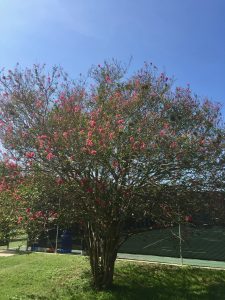Davor Ivkovic
Throughout the semester I have visited my Travis Almanac designated place a dozen times. As I have presented in my first blog entry, I have put all my focus on a beautiful organism – Lagerstroemia indica, commonly known as the Crape Myrtle. Previously I have mentioned that this genus of tree has been designated to be the Texas state shrub. Considering how popular and beautiful it is, that title is for sure well deserved. In the past two and half months, I have observed many interesting things when it comes to this Crape Myrtle. I conducted a research on its origin and habitat preference (brought me to the conclusion that this is not a native tree; it comes from Southeast Asia), seen some disease issues on the tree, and observed some temporal patterns over the course of the semester. In this blog I will discuss some of the phenological observations and the temporal patterns I have observed on the beautiful Crape Myrtle.
On October 10, when I was writing the first blog entry, the Crape Myrtle was still blooming. I mentioned that there are other Crape Myrtles in the surrounding area but they lost their beautiful flowers in September already. Throughout the previous two months and the half I focused on phenological observations. Specifically, I went every week to the spot to see how long the blooming is going to last. According to Collinsworth, “some crape myrtles come into bloom with large clusters of flowers appearing on the tips of new branches in May, while other varieties wait until July or later. Blooms continue into fall. After flowers fade and fall from the tree, the fruit can be cut from the plant to stimulate more blooms in 30 to 45 days” (Collinsworth, 2017). Therefore, these trees are blooming from May all through mid-fall. Also, this explains why some Crape Myrtles bloomed longer in fall and some lost all their flowers early in the fall (because on some the fruit from the plant stimulates more blooms for another month or so). On the photos above we can see a lot of difference when it comes to blooming of the Crape Myrtle. On October 10, a lot of flowers were still there; however, on November 15, all of the flowers faded or fell from the tree. The cold front that came to Austin was one of the reasons for this discontinuation of blooming.
In the first blog entry, I talked about some issues and insects relations that all Crape Myrtle have. In the previous month I observed more carefully the appearance of the sooty mold on the branches. The Plant Pathology Journal conducted a study where they used digital IR technology to look into spatial patterns for temperature distribution on crape myrtle leaves infested with sooty mold. According to them, “In the thermal images, the sooty regions appeared as distinct spots, indicating that the temperatures in these areas were higher than those in the control regions on the same leaves. This suggests that the sooty regions became warmer than their control regions on the adaxial leaf surface” (Kim, 2016, p. 1). This study concludes that there has to be more research conducted in order to find the conclusion why the Crape Myrtles are attacked so much by sooty mold.
During the month of October, I have seen some insects on the organism I observed. I couldn’t tell what they are exactly. Florida Entomological Society conducted a research on using Crape Myrtles as a pollen source by native and non-native bees. According to the study, “Crape myrtle appears to provide a pollen source for several native bee species as well as for honey bees. Evidence suggests that certain combinations of crape myrtle cultivars could provide additional spatial and temporal support for a diversity of functional groups of pollinators and may augment pollinator species richness” (Riddle, 2016, p. 1). Furthermore, when it comes to other insect, study shows that “many insect species including members of the orders Diptera, Coleoptera, Hemiptera, Hymenoptera, Lepidoptera, and Neuroptera have commonly been observed visiting crape myrtle flowers” (p. 3). This study answered my question on whether native insects come to the beautiful flowers of this tree.
This project was extremely interesting and it helped me learn a lot of useful things about ecology, phenology, and nature in general. Throughout the semester of close observation, I’ve encountered some big changes on this organism, from blooming to some diseases issues the organism was facing. This blog helped me learn more about phenological research and how to more closely observe an organism. All in all, it was my pleasure observing this beautiful tree called the Crape Myrtle.
References
Collinsworth, B. (2017). When Do Crape Myrtles Bloom in Texas? Retrieved November 16, 2017, from https://www.nativelanddesign.com/blog/when-do-crape-myrtles-bloom-in-texas
Kim, J., Kweon. (2016). Digital Infrared Thermal Imaging of Crape Myrtle Leaves Infested with Sooty Mold. The Plant Pathology Journal, 32(6), 563–569. Retrieved from http://doi.org/10.5423/PPJ.NT.04.2016.0112
Riddle, T. C., & Mizell, R. F. (2016). Use of Crape Myrtle,Lagerstroemia (Myrtales: Lythraceae), Cultivars as a Pollen Source by Native and Non-Native Bees (Hymenoptera: Apidae) in Quincy, Florida. Florida Entomologist, 99(1), 38-46. doi:10.1653/024.099.0108


